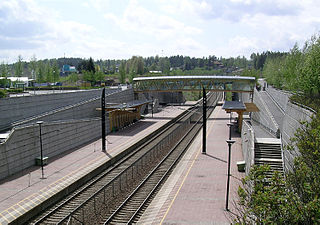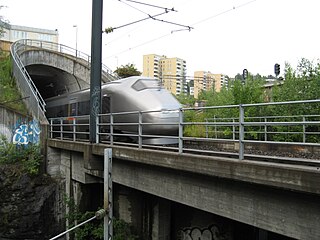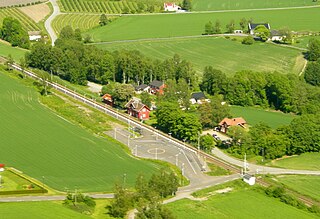
Oslo Airport, alternatively referred to as Oslo Gardermoen Airport or simply Gardermoen, is an international airport serving Oslo, the capital and most populous city of Norway. A hub for Scandinavian Airlines and an operating base for Norwegian Air Shuttle and Widerøe, in 2011, it connected to 26 domestic and 158 international destinations.

The Norwegian railway system comprises 4,109 km of 1,435 mm track of which 2,644 km is electrified and 274 km double track. There are 697 tunnels and 2,760 bridges.
Flytoget is a high-speed airport railway service connecting Oslo Airport to Oslo Central Station. Run by Flytoget AS, it operates on the high-speed Gardermoen Line using sixteen GMB Class 71 electric trains. Normal service frequency is once every ten minutes, with five of the services each hour continuing westwards beyond Oslo Central. The journey takes nineteen minutes, with extended services serving nine stops within Greater Oslo and taking up to 60 minutes.

Vygruppen, branded as Vy, formerly the Norwegian State Railways, is a government-owned railway company which operates most passenger train services and many bus services in Norway. The company is owned by the Norwegian Ministry of Transport. Its sub-brands include Vy Buss coach services, CargoNet freight trains and the Swedish train transport company Tågkompaniet. In 2009, NSB carried 52 million train passengers and 104 million bus passengers. On 24 April 2019, passenger train and bus services were rebranded as Vy.

Oslo Central Station is the main railway station in Oslo, and the largest railway station within the entire Norwegian railway system. It connects with Jernbanetorget station, which is served by trams and the Oslo Metro. It's the terminus of Drammen Line, Gardermoen Line, Gjøvik Line, Hoved Line, Østfold Line and Follo Line. It serves express, regional and local rail services by four companies. The railway station is operated by Bane NOR while its real estate subsidiary, Bane NOR Eiendom owns the station, and was opened in 1980.

Nationaltheatret Station is an underground railway station on the Drammen Line serving Vika and the central business district of Oslo, Norway. It is the second-busiest railway station in Norway, behind Oslo Central Station (Oslo S), from which Nationaltheatret is 1.4 kilometers (0.9 mi) away. Owned and operated by Bane NOR, Nationaltheatret serves regional services to the Vestfold Line and the Oslo Commuter Rail operated by Vy, intercity services on the Sørland Line operated by Go-Ahead Norge, and the Airport Express Train.

The Gardermoen Line is a high-speed railway line between Oslo and Eidsvoll, Norway, running past Lillestrøm and Oslo Airport, Gardermoen. The line is 64 kilometres (40 mi) long and replaced the older Hoved Line as the main line north-east of Oslo. The older Hoved Line now handles commuter and freight traffic, while the Gardermoen Line handles high-speed passenger trains and freight trains laden with jet fuel for the airport. Both lines are owned by Bane NOR.

NSB Class 71 is an electric multiple unit used by Flytoget for the Airport Express Trains on the Gardermoen Line of Norway. Sixteen three-car train sets were built by Adtranz Strømmen between 1997 and 1998. The units are capable of 210 km/h (130 mph), connecting Oslo Central Station and other stations in Metropolitan Oslo to the Oslo Airport, Gardermoen, along Norway's only high-speed railway.

Skøyen Station is a railway station located at Skøyen in Oslo, Norway. It is situated on the Drammen Line, 4.36 kilometers (2.71 mi) from Oslo Central Station. It is served by regional trains and the Oslo Commuter Rail, operated by Vy, as well as by the Airport Express Train. The station is elevated and has two island platforms and four tracks.

The Asker Line is a 9.5-kilometre (5.9 mi) railway line between Asker and Lysaker in Norway. The line runs along the same corridor as the Drammen Line, offering increased capacity, speed and regularity on the rail network west of Oslo. The first part opened in 2005, and in 2011 an extension opened from Sandvika to Lysaker. Original plans called for an extension to Skøyen, but from 2020, new planning is under way for an extension all the way to Oslo Central Station. Most of the railway is in tunnel and is dimensioned for 160 km/h (99 mph) running. The entire railway is electrified at 15 kV 16.7 Hz AC. The first section cost 3.7 billion kr, while the second is budgeted at NOK 2.7 billion.

Lysaker Station is a railway station on the Drammen Line and Asker Line situated at Lysaker in Bærum, Norway. Located 7.00 kilometers (4.35 mi) from Oslo Central Station, Lysaker is served by a mix of Vy express, regional and Oslo Commuter Rail trains, as well as Flytoget. The station is elevated and features two island platforms with four tracks. It's the terminus of the Asker Line.

The Romerike Tunnel is a 14.580-kilometre (9.060 mi) railway tunnel in Norway between Oslo and Lillestrøm. It is the second longest railway tunnel in Norway after the Blix Tunnel opened in 2022, and forms the first section of the Gardermoen Line. It is double track and electrified, permitting speeds of 210 kilometres per hour (130 mph).
Lillestrøm Station is a railway station serving the town of Lillestrøm in Skedsmo, Norway. Located on the Gardermoen Line and the Trunk Line as well as being the western terminus of the Kongsvinger Line, it is the main transport hub of the eastern parts of the Greater Oslo area, and all trains east of Oslo – local, regional, airport express, and long-distance express – call at Lillestrøm.

Asker Station is a railway station located in downtown Asker, Norway. Situated on the Drammen Line, 23.83 kilometers (14.81 mi) from Oslo Central Station, it also serves as the terminus of the Asker Line and the Spikkestad Line. The station is located just southwest of the Asker Tunnel and the Skaugum Tunnel, and just northeast of the Lieråsen Tunnel. Vy serves the station with local, regional and intercity trains. It is also served by the Airport Express Train and serves as the main bus terminal for the town. The station has six tracks and four platforms, consisting of two island platforms and two side platforms. The station had 8,400 daily passengers in 2008.

Sandvika Station is a railway station located at Sandvika in Bærum, Norway. Situated on the Drammen Line, 14.14 kilometers (8.79 mi) from Oslo S, it also an intermediate station of the Asker Line. Vy serves the station with local and regional, with about 7,000 passengers using the station daily. It is also served by the Airport Express Train and serves as the main bus terminal for the town. The station is elevated and has two island platforms and four tracks.

Eidsvoll is a railway station located at Eidsvoll in Akershus, Norway. The station is a terminal of the Trunk Line, the Gardermoen Line, and the Dovre Line. Though the Dovre Line and the Trunk Line/Gardermoen Line practically are the same continual railway, there is a naming change at the station, thus making it a terminus for all the three lines. The station serves the Oslo Commuter Rail to Kongsberg and regional trains to Lillehammer, Drammen and Skien. In the summer the paddle steamer Skibladner operates from the docks at the station.

Eidsvoll Verk Station is a railway station located on the Gardermoen Line at Råholt near Eidsvoll Verk in Eidsvoll, Norway. The station was taken into use in 1999 when the commuter trains to Eidsvoll started using the Gardermoen Line. It was designed by Arkitektskap and built in concrete, with details in metal and wood, and is sunk into the ground.

Oslo Commuter Rail is a commuter rail centered in Oslo, Norway, connecting the capital to six counties in Eastern Norway. The system is operated by Vy and its subsidiary Vy Gjøvikbanen, using Class 69 and Class 72 electric multiple units (EMU). The network spans eight routes and 128 stations, with Oslo Central Station (Oslo S) as the central hub. The trains run on 553 kilometers (344 mi) of electrified mainline railway owned by the Bane NOR. Deficits are financed by the Norwegian Ministry of Transport, although the network also has a ticketing cooperation with Ruter, the public transport authority in Oslo and Akershus. The network is the longest commuter rail network in the Nordic countries, and among top ten in Europe.

Torp Station, also known as Sandefjord Airport Station, is on the Vestfold Line in Sandefjord Municipality, in Vestfold county, Norway. It is served with regional trains operated by Vy. Located close to Sandefjord Airport, Torp, the station is served by a free four-minute shuttle bus service from the station to the airport. The trains operate northwards via towns in Vestfold to Drammen and Oslo and onwards via Oslo Airport, Gardermoen to towns in Innlandet county. Southwards, the trains serve Sandefjord, Larvik and Grenland.

The Hurum Line was a proposed railway line which would have connected Røyken and Hurum in Asker municipality, Norway. Launched during the Oslo Airport location controversy during the second half of the 1980s, its main purpose was to act as an airport rail link to serve the proposed national airport on Hurumlandet. The main proposal for the line called for a 14-kilometer (8.7 mi) section of double track which would branch from the Spikkestad Line at Hallenskog. Construction of the Hurum Line would have seen 7 kilometers (4.3 mi) of the Spikkestad Line upgraded to double track as well as upgrades to the Drammen Line. The distance from Hurum to Oslo is 45 kilometers (28 mi), with travel time estimated at 35 minutes.




















